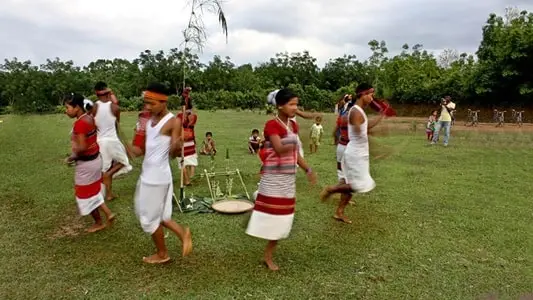Tripura is a state located in the North-Eastern part of India. It is a state with a rich cultural diversity and is inhabited by many tribal communities. This is reflected in the diverse folk dances of the state as well. Whether it is the largest tribal community in the state, called Tripuri, or other tribal communities such as Reang or Chakma, each has its own distinctive folk dance forms. Let’s look at some of the major folk dances of Tripura.
Folk Dance Styles of Tripura
1. Goria/Garia

Goria or Garia is a folk dance performed by the Tripuri community. This dance form is associated with the Jhum or shifting cultivation practiced by the Tripuri community. Garia dance is performed during the commencement of the sowing season, called Ghoria Puja, in April. The festival, characterized by the Garia dance, is held to pray for a bountiful harvest.
Garia dance is performed by both men and women to the tunes of drums and flutes. Members of other tribal communities also join in the celebrations. The dancers move from village to village. The dance movements involve various mudras showcasing various natural phenomena. Goria Puja lasts for a total of 7 days.
2. Hojagiri
Hojagiri dance is performed by young women belonging to the Reang tribe on the night of the Hojagiri festival and other special occasions. This is a very difficult dance form requiring a great deal of skills. The dancer stands on an earthen pitcher and balances a bottle with a lighted lamp atop it while twisting the lower part of the body in a belly dancing manner while maintaining restricted movements of the upper part.
Reang women usually dress up in black Pachra and Rea for the dance performance. Besides, they cover the upper part of the body with coin rings and wear rings made of coins and flowers. Musical instruments for Hojagiri dance performances include the Khamb, bamboo flute, and bamboo cymbal.
3. Lebang Boomani
Lebang Boomani dance is associated with the period before the onset of the monsoon season and is performed by the Tripuri youth. Lebang refers to colourful insects which visit the hills in search of seeds during this season. The concept of this dance form is based on the fun and frolic associated with the annual visit of the Lebang insects.
While the men produced rhythmic sounds using bamboo chips to attract the Lebang insects out of their hiding places, the women ran around the hill slopes to catch them. Lebang Boomani dance depicts this activity. The women dancers wear varied kinds of ornaments such as silver bangles, bronze noses and earrings, and chains made of silver and coins. A host of musical instruments, such as chamber, flute, sarinda, and cymbals made of bamboo, are used for the performances.
4. Hai Hak
Hai Hak dance is the traditional dance form of the Molsom community, which is a sub-tribe of the Halam tribe. The community’s female members mainly perform it in honor of Goddess Lakshmi at the end of the harvesting season. The dance steps depict the activities of the tribal community involved in jhum cultivation, such as clearing the field, sharpening the knives, cutting the paddy, and others.
5. Bijhu
Bijhu is a folk dance associated with the Chakma community. It is traditionally performed to celebrate Chaitra Sankranti, which marks the end of Bengali year and the start of a new Bengali year. This dance form is primarily performed by Chakma women wearing flowers and metal ornaments on their hair. The rhythmic steps are performed to the tunes of flute and indigenous instruments.
Santosh Kumar is a Professional SEO and Blogger, With the help of this blog he is trying to share top 10 lists, facts, entertainment news from India and all around the world.
